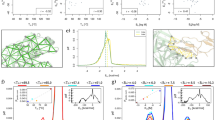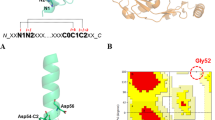Abstract
In this study we examined microenvironment of Trp residues in “dry” sets of nonhomologous proteins that belong to four structural classes, as well as in a “wet” set. In silico experiments showed that residues of Trp demonstrate higher surface accessibility in proteins of “alpha/beta” class where they are rarely included in beta strands. However, this feature has not caused “red” shift in fluorescence spectra in “alpha/beta” proteins in vitro, since there are several factors that should be combined together to cause it: high surface accessibility and high hydrophilicity of the microenvironment, the presence of destabilizing contacts with Asp, Asn, Leu, and multiple Tyr residues, as well as the lack of stabilizing interactions with Arg, Thr, and Pro. The occurrence of Trp residues has the highest value in beta-structural proteins, while they are not involved in aromatic–aromatic interactions with each other as frequently, as they do in proteins of “alpha + beta” class in which Trp residues are overrepresented near each other in the primary sequence. That is why the deformation of circular dichroism spectra because of Trp–Trp interactions is expected to be more frequent in proteins of “alpha + beta” class. In all four classes of proteins Trp residues are involved in long-range interactions with some hydrophobic (Leu, Val, Ile) and aromatic residues (Trp, Phe, and Tyr) more frequently than it is expected. They are involved in long-range interactions with some hydrophilic residues (Asp, Glu, Ser, and Lys) rarely than it is expected. Short-range interactions between Arg and Trp are overrepresented just in alpha-helical proteins.








Similar content being viewed by others
References
Ahmad S, Gromiha M, Fawareh H, Sarai A (2004) ASAView: database and tool for solvent accessibility representation in proteins. BMC Bioinform 5:51
Broos J, Tveen-Jensen K, de Waal E, Hesp BH, Jackson JB, Canters GW, Callis PR (2007) The emitting state of tryptophan in proteins with highly blue-shifted fluorescence. Angew Chem Int Ed Engl 46(27):5137–5139
Burley SK, Petsko GA (1985) Aromatic–aromatic interaction: a mechanism of protein structure stabilization. Science 229(4708):23–28
Burstein EA, Vedenkina NS, Ivkova MN (1973) Fluorescence and the location of tryptophan residues in protein molecules. Photochem Photobiol 18(4):263–279
Chen Y, Barkley MD (1998) Toward understanding tryptophan fluorescence in proteins. Biochemistry 37:9976–9982
Greenfield NJ (2006) Using circular dichroism spectra to estimate protein secondary structure. Nat Protoc 1(6):2876–2890
Hamdi OA, Feroz SR, Shilpi JA, Anouar EH, Mukarram AK, Mohamad SB, Tayyab S, Awang K (2015) Spectrofluorometric and molecular docking studies on the binding of curcumenol and curcumenone to human serum albumin. Int J Mol Sci 16:5180–5193
Kabsch W, Sander C (1983) Dictionary of protein secondary structure: pattern recognition of hydrogen-bonded and geometrical features. Biopolymers 22:2577–2637
Khrustalev VV, Khrustaleva TA, Lelevich SV (2017) Ethanol binding sites in proteins. J Mol Graph Model 78:187–194
Khrustalev VV, Khrustaleva TA, Kahanouskaya YU, Rudnichenko YA, Bandarenka HV, Arutyunyan AM, Girel KV, Khinevich NV, Ksenofontov AL, Kordyukova LV (2018a) The alpha helix 1 from the first conserved region of HIV1 gp120 is reconstructed in the short NQ21 peptide. Arch Biochem Biophys 638:66–75
Khrustalev VV, Khrustaleva TA, Poboinev VV (2018b) Amino acid content of beta strands and alpha helices depends on their flanking secondary structure elements. Biosystems 168:45–54
Kyte J, Doolittle RF (1982) A simple method for displaying the hydropathic character of a protein. J Theor Biol 157:105–132
Lakowicz JR (2002) Topics in fluorescence spectroscopy: biochemical applications. Kluwer Academic Publishers, New York
Lakowicz JR (2006) Principles of fluorescence spectroscopy. Spinger, Berlin
Najor MS, Olsen KW, Graham DJ, Mota de Freitas D (2014) Contribution of each Trp residue toward the intrinsic fluorescence of the Giα1 protein. Protein Sci 23(10):1392–1402
Philip V, Harris J, Adams R, Nguyen D, Spiers J, Baudry J, Howell EE, Hinde RJ (2011) A survey of aspartate–phenylalanine and glutamate–phenylalanine interactions in the protein data bank: searching for anion–π pairs. Biochemistry 50(14):2939–2950
Pinheiro S, Soteras I, Gelpí JL, Dehez F, Chipot C, Luque FJ, Curutchet C (2017) Structural and energetic study of cation–π–cation interactions in proteins. Phys Chem 19(15):9849–9861
Pletneva EV, Laederach AT, Fulton DB, Kostic NM (2001) The role of cation–pi interactions in biomolecular association. Design of peptides favoring interactions between cationic and aromatic amino acid side chains. J Am Chem Soc 123(26):6232–6245
Roy A, Keiderling TA (2009) TD-DFT modeling of the circular dichroism for a tryptophan zipper peptide with coupled aromatic residues. Chirality 21:163–171
Samanta U, Pal D, Chakrabarti P (2000) Environment of tryptophan side chains in proteins. Proteins. 38(3):288–300
Tina KG, Bhadra R, Srinivasan NPIC (2007) Protein interactions calculator. Nucleic Acids Res 35:W473–W476
Vivian JT, Callis PR (2001) Mechanisms of tryptophan fluorescence shifts in proteins. Biophys J 80(5):2093–2109
Woody RW (1994) Contributions of tryptophan side chains to the far-ultraviolet circular dichroism of proteins. Eur Biophys J 23(4):253–262
Author information
Authors and Affiliations
Corresponding author
Additional information
Publisher's Note
Springer Nature remains neutral with regard to jurisdictional claims in published maps and institutional affiliations.
Electronic supplementary material
Below is the link to the electronic supplementary material.
Rights and permissions
About this article
Cite this article
Khrustalev, V.V., Poboinev, V.V., Stojarov, A.N. et al. Microenvironment of tryptophan residues in proteins of four structural classes: applications for fluorescence and circular dichroism spectroscopy. Eur Biophys J 48, 523–537 (2019). https://doi.org/10.1007/s00249-019-01377-0
Received:
Revised:
Accepted:
Published:
Issue Date:
DOI: https://doi.org/10.1007/s00249-019-01377-0




